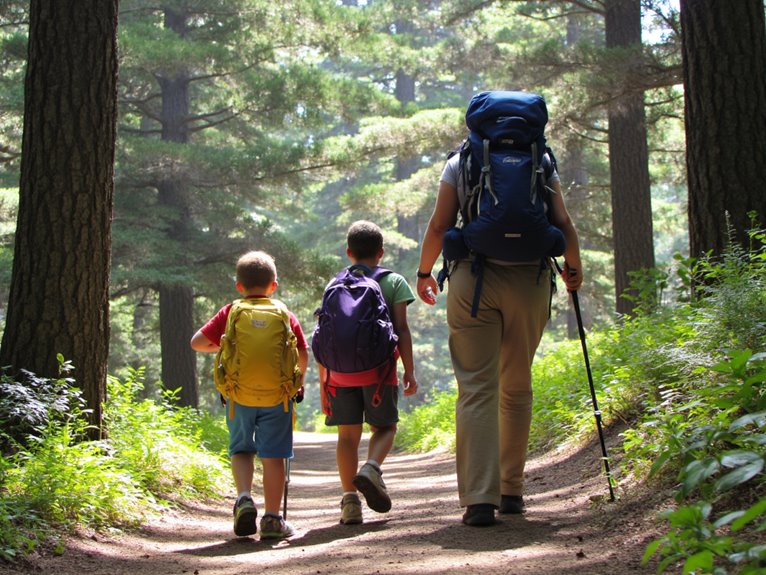Family Backpacking: Age-Appropriate Distances and Gear
You’ll need to match hiking distances to your child’s age: toddlers manage 2 miles maximum, ages 4-7 handle 2-5 miles, kids 8-12 can hike 6-10 miles, and teens approach adult capabilities at 6-12 miles. Backpack weight shouldn’t exceed 10% of body weight for day hikes or 20% for multi-day trips. Select age-appropriate gear like Kinderpack Preschool for ages 3-5 or Osprey Ace 50 for older children. Proper planning prevents injury and builds lifelong outdoor enthusiasm through these foundational principles.
We are supported by our audience. When you purchase through links on our site, we may earn an affiliate commission, at no extra cost for you. Learn more. Last update on 7th January 2026 / Images from Amazon Product Advertising API.
Notable Insights
- Children aged 4-7 can hike 2-5 miles daily, while ages 8-12 handle 6-10 miles following one kilometer per year.
- Day hikers should carry maximum 10% body weight; multi-day trips allow up to 20% with ultralight gear essential.
- Ages 3-5 need lightweight packs under 5% body weight; ages 6-8 use proper hip belts for 10% loads.
- Heat above 95°F reduces children’s exercise tolerance significantly; cold and humidity also impact hiking performance substantially.
- Essential safety gear includes age-appropriate first aid kits, GPS trackers, emergency signaling devices, and proper hydration systems.
Hiking Distance Guidelines by Age Group
Planning hiking distances for family backpacking trips requires careful consideration of each child’s age and physical capabilities.
Children aged 0-3 years can’t manage more than 2 miles, requiring you to carry them most of the time. Ages 4-7 typically handle 2-5 miles daily, depending on terrain and weather conditions.
The 8-12 age group manages 6-10 miles, following the rule of approximately one kilometer per year of age. Teenagers aged 13-17 can tackle 6-12 miles, approaching adult distances.
Hiking safety demands matching trail choices to your child’s abilities. Flat terrain works best for younger children, while older kids handle elevation gains.
Always prioritize frequent breaks, proper hydration, and positive experiences over ambitious distance goals. When selecting gear for overnight trips, choose sleeping bags with appropriate temperature ratings based on expected nighttime conditions to ensure comfortable rest for the entire family.
Backpack Weight Recommendations for Young Hikers
When selecting appropriate pack weights for young hikers, you’ll need to follow specific bodyweight percentages that prevent injury while building endurance. Day hikers shouldn’t exceed 10% of their body weight. Multi-day trips allow up to 20% maximum load limits.
A 60-pound child carries 6 pounds maximum for day hikes, 12 pounds for overnight trips. These percentages aren’t rigid rules. Individual strength, height, and fitness levels matter more than strict calculations. Taller but less muscular children need weight reductions below standard guidelines.
Gear efficiency becomes critical for longer expeditions. Choose ultralight, multi-functional equipment whenever possible. Share communal items among family members to distribute weight effectively.
Proper backpack fit distributes loads evenly across shoulders and hips, reducing perceived weight considerably. Regular pack adjustments during hikes prevent fatigue accumulation.
Environmental Factors That Impact Children’s Hiking Ability
When you’re planning family hikes, environmental conditions directly affect your child’s physical performance and safety on the trail.
Weather patterns like sudden temperature drops or intense heat can quickly overwhelm young hikers whose developing thermoregulatory systems can’t adapt as efficiently as adults.
Terrain features such as steep inclines, loose rocks, and muddy surfaces create additional challenges that require you to assess your child’s motor skills and endurance capacity before selecting appropriate hiking routes.
Investing in waterproof backpacks designed for young hikers ensures their essential gear stays dry during unexpected rain showers or stream crossings that could otherwise lead to hypothermia from wet clothing.
Weather and Temperature Effects
Understanding how weather conditions affect your child’s hiking performance is essential for safe and enjoyable outdoor adventures.
Children’s thermoregulation systems differ greatly from adults, making them more vulnerable to temperature extremes. Weather patterns directly influence their exercise tolerance and hiking capacity.
Temperature adaptation requires careful consideration:
- Heat above 95°F reduces exercise tolerance due to less effective sweating mechanisms
- Every 10°F temperature increase decreases moderate activity by 17 minutes daily
- Cold temperatures also impair performance, reducing activity by 5 minutes per 10°F drop
- High humidity compounds heat stress, further limiting endurance
Children generate more metabolic heat per body mass during exertion.
They also acclimatize to heat more slowly than adults, requiring gradual exposure over days or weeks for peak performance.
In cold conditions, children lose body heat faster than adults, making proper thermal regulation through layering and insulated gear critical for maintaining warmth during family hiking adventures.
Terrain Difficulty Considerations
Beyond temperature and weather conditions, the physical characteristics of hiking terrain greatly impact your child’s performance and safety on the trail. Uneven surfaces with loose rocks, roots, and mud demand enhanced balance and precise foot placement from young hikers.
Steep inclines elevate physical demands greatly, causing faster exhaustion and requiring stronger cardiovascular stamina that varies by age.
Rocky scrambles and log obstacles challenge developing motor skills, while soft, well-packed surfaces enable easier walking with reduced fatigue. These terrain challenges directly influence hiking pace and distance capabilities.
Hidden cliff edges, fast-moving streams, and shifting rocks present serious hazards requiring constant vigilance.
However, appropriate terrain challenges build balance, strength, and problem-solving abilities when properly supervised. Developing safety awareness through progressive difficulty exposure prepares children for more challenging adventures while maintaining manageable risk levels. Proper footwear with aggressive tread patterns becomes essential for young hikers navigating rocky paths and uneven terrain safely.
Building Endurance Through Progressive Training

Building endurance for family backpacking requires a systematic approach that gradually increases physical demands on your body over time.
Progressive overload stimulates hiking adaptations by adding weekly mileage increments while maintaining manageable intensity levels.
Start with shorter distances appropriate for your family’s current fitness baseline.
Implement endurance exercises that mirror trail conditions:
- Step-ups and stair climbing with weighted packs to simulate elevation gain
- Calf raises and core strengthening for stability on uneven surfaces
- Uphill and downhill walking to prepare muscles for eccentric contractions
- Full-body strength training targeting legs, hips, shoulders, and back
Schedule mandatory rest days between intensive sessions.
This recovery period allows muscle repair and prevents overtraining syndrome.
Monitor children’s fatigue levels closely and adjust training loads accordingly.
Consistency builds confidence while proper progression minimizes injury risk across all age groups.
Begin your family’s preparation 8 weeks prior to your planned backpacking adventure to allow adequate time for physical adaptations.
Essential Gear Selection for Different Age Categories
When selecting backpacking gear for your family, you’ll need different equipment categories based on each child’s age and physical development.
Your gear choices must balance safety requirements with age-appropriate pack weights-from soft carriers for infants to adult-style packs for teenagers.
The right combination of age-specific pack selection and essential safety gear guarantees every family member stays comfortable and secure on the trail.
For families with toddlers, hiking backpack carriers should accommodate children from 16 pounds minimum up to 33-50 pounds maximum, with proper safety certifications like ASTM F2549 to ensure secure transport during outdoor adventures.
Age-Specific Pack Selection
Selecting the right backpack for your child depends primarily on their age, physical development, and carrying capacity. Age specific comfort requires careful weight calculations and proper sizing to verify pack safety throughout your adventures.
For different age groups, consider these guidelines:
- Ages 0-3: External frame carriers with 42-pound weight limits work best, while toddlers need harness-equipped packs for essential items.
- Ages 3-5: Lightweight packs like the Kinderpack Preschool shouldn’t exceed 5% of body weight.
- Ages 6-8: Models such as Deuter Fox 40 can handle 10% of body weight with proper hip belts.
- Ages 9-12: Quality packs like Osprey Ace 50 accommodate 10-15% body weight with ventilation systems.
Proper pack selection prevents fatigue and injury while building independence. Adding quality hiking insoles to your child’s boots can reduce muscle fatigue by up to 50% and provide essential arch support during long trail days.
Safety Gear Essentials
Since each age group presents unique safety challenges on the trail, your family’s protection strategy must adapt accordingly.
Toddler safety requires complete first aid kits with infant-appropriate medications like Benadryl, plus broad-spectrum sunscreen and UV-protective hats.
Young children need lightweight waterproof rain jackets, wool hiking socks for moisture management, and child-friendly hydration systems.
Older children require fully stocked first aid supplies, high-quality ankle-support boots, and communication tools like GPS trackers with parental controls.
Teens need advanced first aid kits addressing sprains and serious wounds, plus navigation tools combining traditional compass skills with GPS technology.
All age groups require emergency signaling devices, moisture-wicking protective layers, and consistent hydration solutions tailored to capacity needs. When selecting footwear for any family member, prioritize boots with proper fit and reliable waterproof protection to prevent blisters and maintain dry feet throughout your adventure.
Safety Planning and Risk Management Strategies
Although hiking carries remarkably low mortality risks at just 0.1 deaths per 100,000 recreation visits-nearly 8,440 times safer than general population mortality rates-proper safety planning remains essential for family backpacking trips.
Develop thorough safety training protocols before departing. Create specific rules for children including staying on marked trails and avoiding unknown plants.
Wildlife education should cover local animal behavior and proper response techniques.
Your risk management strategy must address the top hiking hazards:
- Water safety: Purify all water sources to prevent diarrhea (affecting 56% of wilderness hikers)
- Hygiene protocols: Clean cooking utensils and practice handwashing to reduce illness risk by 50%
- Trail awareness: Maintain marked path adherence to minimize wildlife encounters
- Emergency procedures: Establish clear protocols for getting lost or wildlife threats
Pack lightweight portable water filters that achieve 99.999% bacterial removal to ensure safe drinking water throughout your family backpacking adventure.
Discuss realistic scenarios with children beforehand to make certain they understand safety expectations and responses.
Keeping Kids Motivated on the Trail
With safety protocols established, your attention turns to maintaining children’s enthusiasm throughout the hiking experience. Nature games like “I Spy” and scavenger hunts targeting specific wildlife sightings transform passive walking into active exploration. Set achievable short-term goals every 0.5-1 miles to maintain forward momentum.
Assign age-appropriate responsibilities including lightweight gear management and navigation assistance. Children aged 6-8 can carry 10-15% of their body weight, while 9-12 year-olds manage up to 20%.
Implement positive reinforcement through verbal praise and strategic snack rewards at predetermined intervals.
Allow children autonomy in route selection and pacing decisions where terrain permits. Incorporate beloved toys or “trail stuffies” for psychological comfort.
Practice sessions using actual gear in familiar environments reduce equipment-related complaints. Rest breaks featuring storytelling refresh energy levels while maintaining engagement throughout extended hiking periods. When selecting water filtration systems for family trips, prioritize ultralight options under 3 ounces that children can easily operate and maintain.
Advanced Tips for Experienced Young Backpackers
As your young backpacker gains trail experience and physical capability, it’s time to shift from basic family hiking toward more technical wilderness adventures.
Advanced young hikers require specialized equipment and skills that prioritize weight reduction and self-sufficiency.
Essential upgrades include:
- Lightweight backpacks with anatomically correct sizing for smaller frames and adjustable torso lengths
- Ultralight sleep systems featuring three-quarter length pads that maintain core insulation while reducing pack weight
- Advanced navigation tools including topographic maps, compass skills, and GPS devices for cellular-independent wayfinding
- Physical conditioning programs targeting full-body strength with loaded pack training for downhill terrain management
Gear maintenance becomes critical at this level-teach proper equipment care and field repairs.
Hydration strategies shift toward minimal water carrying (1 liter maximum) combined with reliable filtration systems for source-dependent hydration management.
For experienced young backpackers, consider packs with removable hipbelts and ventilation systems specifically designed for smaller builds to enhance comfort without overwhelming the user.
Frequently Asked Questions
How Do I Handle Diaper Changes and Potty Breaks on Multi-Day Backpacking Trips?
You’ll need efficient diaper storage and portable changing systems for multi-day trips.
Pack a dedicated kit with wet/dry bags, travel wipes, and hand sanitizer. Choose flat, sheltered spots off-trail for changes. Use waterproof changing mats for clean surfaces. Carry all waste out in sealed containers.
For potty-training toddlers, identify discreet locations and maintain hygiene supplies. Monitor weather conditions and protect children from exposure during breaks.
What Sleeping Arrangements Work Best for Families in Small Backpacking Tents?
Position children on the tent’s outer perimeter with adults centrally located for ideal sleeping configurations. This head-to-toe arrangement provides quick nighttime access to kids while maximizing space efficiency.
Your tent organization should prioritize the nursing parent next to infants and establish consistent sleeping order. Use sleeping pads as elevated surfaces to reduce ground heat loss.
Arrange gear in vestibules to separate storage from sleeping areas, improving comfort and accessibility.
How Can I Manage Meal Planning When Kids Are Picky Eaters?
You’ll need multiple meal alternatives to accommodate varying preferences on trail.
Pack customizable options like DIY wraps with separate fillings, instant oatmeal with mix-ins, and deconstructed “lunchables” using crackers and individual protein packets.
Bring familiar flavor enhancements such as shelf-stable condiments, cheese wedges, and powdered seasonings.
Focus on nutrient-dense snacks accessible throughout the day, allowing flexible eating patterns rather than rigid meal schedules.
What Should I Do if My Child Gets Homesick on Overnight Trips?
When your child experiences homesickness on overnight trips, allow comfort items like stuffed animals or family photos to provide emotional anchoring.
Encourage communication through predetermined check-in schedules, but avoid promising early pickup.
Establish familiar bedtime routines using similar snacks and quiet time rituals from home.
Connect them with trusted peers or caring staff members for social support, and validate their feelings while emphasizing the temporary nature of discomfort.
How Do I Teach Kids Leave No Trace Principles in Practice?
You’ll teach Leave No Trace principles through hands-on demonstrations during actual outdoor experiences.
Start with simple phrases like “pack it in, pack it out” and “stay on the trail.”
Use interactive games to identify durable camping surfaces and wildlife observation techniques.
Assign specific tasks like carrying trash bags and monitoring group noise levels.
Outdoor Education works best when kids practice real scenarios rather than abstract concepts.
On a final note
You’ve now got the technical framework to plan successful family backpacking trips. Start with conservative distance targets: 1-2 miles for preschoolers, 3-5 miles for elementary kids. Keep pack weights under 10-15% of body weight. Apply progressive training principles over 4-6 weeks before major trips. Select age-appropriate gear with proper sizing and weight specifications. Implement layered safety protocols and motivation strategies. You’ll build confident young backpackers through systematic, evidence-based approaches.


